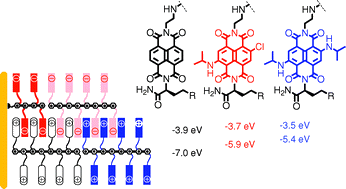- Sakai, N.; Kishore, R. S. K.; Matile, S. “Three-component Zipper Assembly of Photoactive Cascade Architectures with Blue, Red and Colorless Naphthalenediimide Donors and Acceptors” Org. Biomol. Chem. 2008, 6, 3970-3976

We report the programmed (“zipper”) assembly of photoactive rigid-rod π-stack architectures composed of blue (b), red (r) and colorless (n) core-substituted naphthalene diimides (NDIs) attached along p-oligophenyl (POP) rods. The design strategy and multistep syntheses of the required NDI-POP conjugates are described first. The activity of the obtained up to three-component cascade architectures is characterized in current-voltage curves, which are analyzed to reveal short circuit currents and fill factors as significant characteristics. With one-component zippers, rNDIs are found to give much higher photocurrents than bNDIs. In two-component zippers, substitution of rNDIs by nNDIs in meaningful positions is shown to give increased photocurrents despite reduced absorption of light. Three-component zippers are shown to provide access to an increased structural complexity for more subtle control of function. Reaching from 0.27 to 0.54, fill factors, a measure for the power generated with light, are found to be most sensitive to the directionality of multicomponent cascade architectures. Overall, these results are in agreement with photoinduced charge separation between rNDI (but not bNDI) acceptors and POP donors followed by directional intrastack electron transfer from rNDI radical anions to nNDI acceptors, that is, the formation of supramolecular cascade n/p-heterojunctions.
DOI: 10.1039/b808288j
open archive unige:7048 • pdf ![]()
